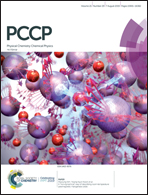Effects of solvent molecules on hemi-bonded (CH3SH)2+: infrared absorption of [(CH3SH)2–X]+ with X = H2O, (CH3)2CO, or NH3 and (CH3SH)n+ (n = 3–6)†
Abstract
Three-electron two-center (3e-2c) hemi-bonds play important roles in the oxidation and electron transport of proteins and are implicated to be involved in some neurodegenerative diseases. Our previous investigations on infrared (IR) spectra of (CH3SH)2+ using vacuum-ultraviolet photoionization, infrared dissociation, and time-of-flight detection have shown that (CH3SH)2+ is (3e-2c)-bonded. To investigate the influence of the solvent molecules on the (3e-2c)-bonded (CH3SH)2+ in a supersonic jet, we added H2O or (CH3)2CO or NH3 or (CH3SH)n (n = 1–4) to (CH3SH)2+ and investigated their IR action spectra. The (3e-2c)-bonded (CH3SH)2+ ion core was maintained when a molecule of H2O or (CH3)2CO or CH3SH binds, indicating that the ion core is more stable than the hydrogen bond, whereas the (3e-2c)-bond became broken by a NH3 molecule because the proton transfer led to a more stable hydrogen-bonded structure. The spectral features of the SH-stretching modes of (CH3SH)n+ (n = 3–6) indicate that the (3e-2c)-bonded (CH3SH)2+ ion core is maintained and the first two additional CH3SH are H-bonded to the free SH groups of the ion core. For larger clusters with n = 5 and 6, the additional solvent molecules likely bind to the first solvation shell. These results show also that the (3e-2c)-bonded S∴S structure is more stable than the S∴O and S∴N structures in [(CH3SH)2–X]+ with X = H2O or (CH3)2CO or CH3SH or NH3.
![Graphical abstract: Effects of solvent molecules on hemi-bonded (CH3SH)2+: infrared absorption of [(CH3SH)2–X]+ with X = H2O, (CH3)2CO, or NH3 and (CH3SH)n+ (n = 3–6)](/en/Image/Get?imageInfo.ImageType=GA&imageInfo.ImageIdentifier.ManuscriptID=C9CP03158H&imageInfo.ImageIdentifier.Year=2019)


 Please wait while we load your content...
Please wait while we load your content...